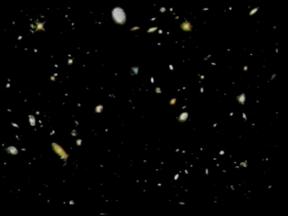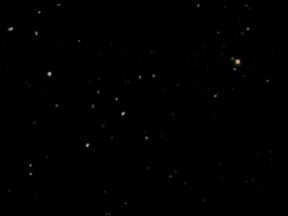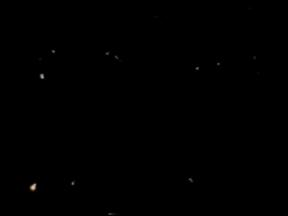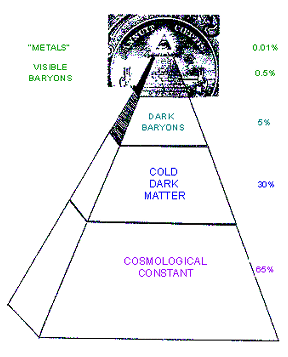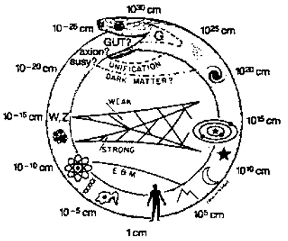Some Modern PicturesWell, what is the modern picture? I do not think there is one - instead, there are many, each of which captures part of the universe. One of the modern icons, one that is engraved
on every person’s imagination, is the view of the Earth from space - in
particular, perhaps, the view that the astronauts first had from orbit around
the Moon, with the dead gray lunar landscape in the foreground, and the
gorgeous blue ever-changing Earth in the distance.
Figure 2. Earthrise from Apollo 11 in lunar orbit. The Hubble Deep Field was the longest time exposure with Hubble Space Telescope’s camera of any region of the sky. For two weeks, the telescope looked at this same patch of sky continuously. It is a very small region of the sky, about four arc-minutes across. That is the size of the intersection of two crossed sewing needles held at arms’ length. A video of this image was made by Ken Lanzetta and his colleagues at State University of New York at Stony Brook. First the video simply pans across the picture, and every single bright spot you see is a galaxy. Many of these are giant galaxies like the Milky Way, big spiral galaxies that contain a hundred billion stars or so. The picture was taken looking out of the disk of the Milky Way so that there are very few stars in the way, but there are a few stars. The bright cross in the upper left corner of Figure 3(a) is what a near-by star looks like. Now the thing that one has to appreciate as one looks at an image like this, is that one is seeing galaxies super-imposed in front of other galaxies. We see all the galaxies that are reasonably bright, all the way out to the edge of the visible universe.
Figure 3(a).A portion of the Hubble Deep Field Image. It would be wonderful to be able to see these galaxies not stacked on top of each other, but spread out in space and time, and that is what the video is about. It is possible to measure the red-shift of about five hundred of the galaxies and, based on those measurements, to estimate the red-shifts for all the rest from their colors. That is what the Lanzetta group did. And so what this lets us do is to zoom into the picture. We see first the near-by galaxies go sliding away to the sides of the picture, and then, as we go farther and farther in, only the galaxies that are very far away from us are still visible. The first galaxies to disappear are within the nearest billion light years or so. The colors are reasonably accurate, and the fact that the galaxies we can still see are now looking somewhat yellower reflects their red-shift: their light is shifted toward the red end of the spectrum because of the expansion of the universe since their light was emitted. Even about four billion light years away, there are still plenty of big galaxies, but at about seven billion years back there are no more big galaxies visible in this field.
Figure 3(b).When the universe was about half its present age.
Figure 3(c). Back to the first two billion years. By the time we get back to about one billion years after the beginning, the sky is suddenly dark. If there were bright galaxies there, we would see them. We are now at the threshold of the real cosmic dark ages, before the cosmic night was pierced by the first beacons of bright starlight. Now, how do we visualize the whole universe in our minds? We can not paint a picture, because we can not see it from outside - a picture is taken from outside the object, but we’re inside the universe. We can not see all times. As we look out in space, we look back in time. And most of the universe anyway is invisible stuff that we call dark matter. We do not know what it is. We know roughly where it is, but we can not see it, so we can not picture it in the sort of direct way that we are used to. An effective image should say something about the universe as a whole, but it does not need to say everything. Let me show you some examples:
Figure 4. Cosmic Spheres of time. Again, as we look out into space, we look back in time. The near-by universe surrounds us, and this is the part that we are busy exploring now, with the Sloan Digital Sky Survey and other very ambitious projects, but most of the volume of the universe remains only very partially explored. The way we do that exploration by “drilling holes” through the distant universe in very narrow little images like the Hubble Deep Field. Then we study the pictures and try to take them apart to see the evolution of structure. Beyond a certain distance, we do not see any bright galaxies - there may be none! The universe first became transparent about two hundred thousand years after the Big Bang. It is from this sphere - represented by the inside of the outermost band in Figure 4 - that the Cosmic Background Radiation was emitted. This heat radiation from the Big Bang has been traveling to us through all of space ever since. And the very earliest stages of the Big Bang are concentric circles right at the edge of the figure that represent the eras of the great annihilations of the particles that initially populated the universe. There were initially almost equal amounts of matter and anti-matter, but now only the tiny remnant of matter survives. Even earlier were the eras of symmetry-breaking and cosmic inflation. We are surrounded by cosmic spheres of time. Spheres somewhat different from the Medieval conception, however, and much larger. Here is another kind of picture, which represents not time but what the universe is made of.
Figure 5 (a). Cosmic Density Pyramid (top) Now this is a picture that you probably all have in your pockets. It is the reverse of the Great Seal of the United States, which appears on the back of the dollar bill. It was an Egyptian symbol later adopted by the Masons (several of the Founding Fathers were Masons). The pyramid, I am told, symbolizes strength and solidity. Above is the all-seeing eye of God. Now, I am going to use this pyramid in a somewhat different way to represent all the visible matter in the universe. The part on top with the eye, which is about a quarter of the height of the full pyramid, represents the heavy elements, from lithium upward in atomic weight. Astrophysicists call all these elements - carbon, oxygen, nitrogen, silicon, iron, and so on - metals. They total about a hundredth of a percent of critical density. Critical density is the minimum density required for the expansion of the universe to be turned around by the gravitational attraction of all the matter in it. Hydrogen and helium, the two lightest elements, make up more than 99% of the mass of the elements in the universe. The volume of the rest of the pyramid represents all the hydrogen and helium we can see in the form of stars and gas, and this amounts to about half a percent of critical density. But there is much more mass than that. Invisible ordinary matter (atoms that are not lit up) amounts to about 5% of critical density, so ten times more than everything visible.
Figure 5 (b). The full Cosmic Density Pyramid. But there is still much more matter than
that. Most of the mass of matter is
dark matter, probably of the cold dark matter variety, possibly mostly made up
of the lightest supersymmetric partner particles. The amount of matter is dwarfed by what seems to be the dominant stuff of the universe - whatever it is - which we call the “cosmological constant” or “dark energy.” It makes up something like 65% of critical density. This three-dimensional picture of the composition of the universe shows how very little there is of the metals we are made out of (and presumably all intelligent life could be made out of). The full Cosmic Density Pyramid above is also a picture of the universe - of an aspect of the universe, that is. Of course, we would love to know what the mysterious dark matter is, and also why there is a cosmological constant. These are two of the most important open questions in cosmology today. Let us turn to one last pair of images.
Figure 6. The Wedge of Material Reality This is a picture of the possible densities of things. It is a plot of the mass of all things in the universe, from elementary particles up to the whole visible universe, versus their sizes. The ratio of mass to volume equals density. Interestingly, plants and animals, and stars, for that matter, all lie along one line. It is the water density line. As you can see, not all densities are allowed. The two great twentieth century laws of physics - General Relativity and Quantum Mechanics - exclude two regions of the diagram. The line that passes through points A and B (and continues in both directions beyond the figure) represents for every size on the X-axis the maximum mass that could possibly exist in it. If any more mass were crammed in, according to General Relativity it would collapse into a black hole. The line through A and C (and beyond) represents the limit on sizes imposed by Quantum Mechanics. The smallest physical size possible is the Planck size, and things close to that size are considered to be “on the Planck scale.” It is a region 10-33 cm across. We cannot talk about, calculate, or conceptualize anything smaller in a way that has meaning in terms of our current concepts of physics The largest size we know is that of the visible universe, but what exactly does this mean? Expansion of the universe means that space is expanding away from us faster and faster the further out we look. Since the velocity at which a point is moving away from us is always increasing with distance, far enough away space is expanding at the speed of light. That distance from us - which at this era in the history of the universe is about 1028 cm - is the radius of what we call the cosmic “horizon” and is the maximum distance from which we can receive informationin principle. The horizon is a sphere, and we are at the center (Fig. 4). Although we have no reason not to believe space is just the same beyond our horizon, there is no way we can receive any direct information confirming it. Light cannot reach us from a region expanding away from us faster than the speed of light. On the figure there is an error bar for the density of the universe because we do not know more precisely than this the total amount of matter it contains and therefore its mass. The Wedge of Material Reality thus shows us that objects can only exist inside the wedge-shaped region of the plot. From the smallest size, the Planck size, to the largest, the horizon of the universe, is a difference of about 60 orders of magnitude. It is large, but not infinite.
Figure 7. The Cosmic Uroboros Let us draw the possible size scales along
the body of a snake instead of just the horizontal axis in the Wedge of
Material Reality. Now, the laws that are important on different scales are different. The same physical laws apply on all scales, but they are not necessarily equally important. Electricity is much more important on small scales, gravity on large scales. Scale models can never work, because of the way the laws of physics work. Galileo pointed this out in the last of his great books, The Discourses Concerning Two New Sciences, where he showed that if the height of an animal were increased by a factor of three, it could no longer be the same shape. If its bones became three times longer in all directions, they would be 9 times thicker (because the cross-section is proportional to the area) but 27 times more massive (because the mass would scale as the volume,the cube of the height.) To support so much weight, the bones would have to be much thicker. We call the error of applying the laws and viewpoint appropriate to one size scale, to phenomena on another scale, “scale incongruity.” For example, imagining that the Big Bang can be understood using just commonsense physics is scale incongruity. In the early universe, much of the material that we now see all the way out to the cosmic horizon was compressed into a much smaller volume, and such high densities and correspondingly high temperatures require relativistic quantum physics. Another example of scale incongruity: thinking of a molecule as ice or liquid. You need millions of molecules to make the tiniest piece of a snowflake. As one goes up in size scale, and thus complexity, such phase transitions show that one can get new “emergent” phenomena that are qualitatively different. Many people believe the human size is insignificant compared to the cosmic scale. But perhaps you noticed on the Cosmic Uroboros that humans are essentially in the middle of the range of size scales in the universe. There is nothing arbitrary about that. That is where we are, and that is where creatures like us must be on this sort of diagram. Our brains must be as big as they are, to be as complex as they are. The universe is much bigger than we are, because it took billions of years for the universe to reach the level of complexity represented by human life, and it was expanding all that time. Just because we are so much smaller than the cosmic horizon does not mean that we are insignificant. After all, we may be the only creatures in the universe who are beginning to understand it.
Contributed by: Joel Primack and Nancy Abrams |

